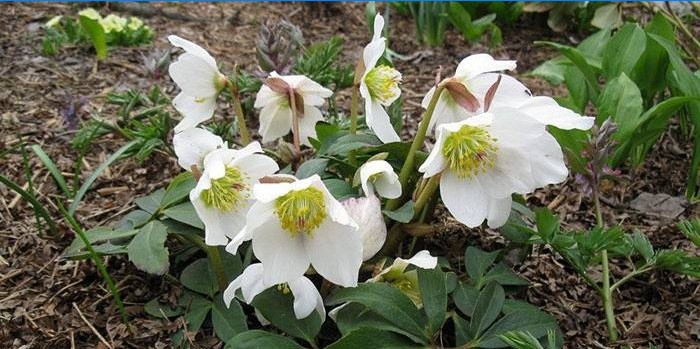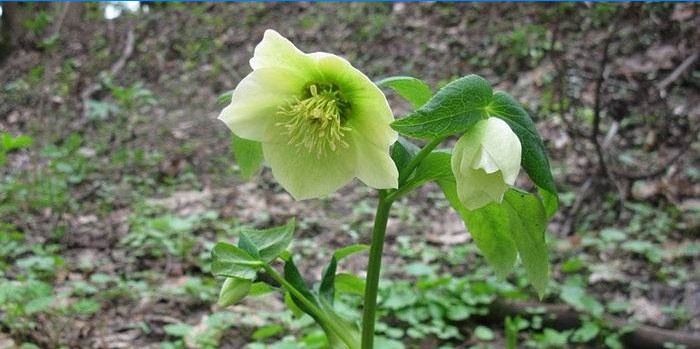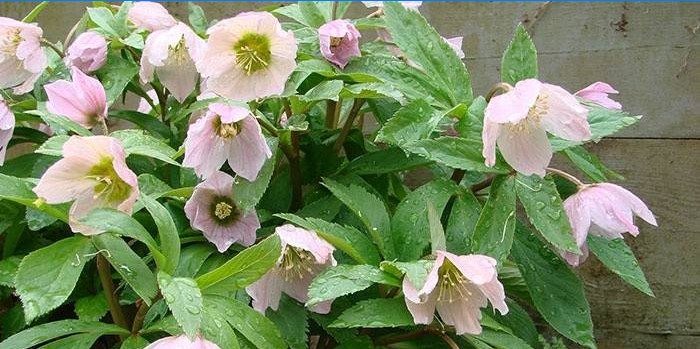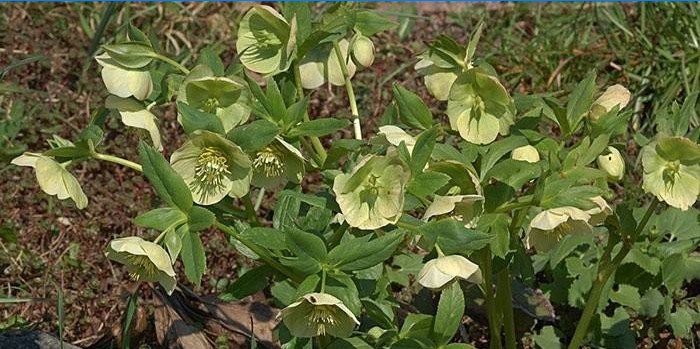The content of the article
- Common types of hellebore with photo
- Black hellebore
- Caucasian hellebore
- Moroznik East
- Christmas rose
- Plant propagation methods
- Seed propagation
- Dividing the bush
- Conditions for growing a hellebore flower
- How to plant hellebore in spring
- How to care for hellebore in open ground
Owners of private homes dream of planting plants in the garden that bloom year-round, unpretentious in care, resistant to pests. Sounds like a fairy tale? But there is such a plant, it has a beautiful flowering and pleases with bright inflorescences of gardeners in the cold season – this is hellebore. Otherwise, it is also called a winter hut. He is not whimsical when landing and leaving. Zimovnik belongs to the genus of perennial herbaceous plants of the buttercup family.
Common types of hellebore with photo
A lot of legends and legends are connected with the winterman. So, according to one of them, his flowers were found by the magi near the barn, where Jesus Christ was born. According to another legend, Alexander the Great died of wintering poisoning. It is believed that the flower is able to cause demons. Hippocrates used the plant as a cleanser. In ancient times, a flower was used to treat insanity and paralysis..

Modern research has revealed that hellebore contains such toxic substances as veratrin, teratogen, cyclopamine, and iervin. When ingested, they cause dizziness, thirst, a feeling of suffocation, swelling, and vomiting. Be careful when growing this plant on a personal plot, make sure that small children or pets do not eat the plant. At the first symptoms of wintering poisoning, consult a doctor.
The plant reaches up to 50 cm in height, has a well-developed root system. Decorative flowers and leaves of hellebore, located close to the ground, form a beautiful rosette. The tall stalk of the plant is crowned with beautiful inflorescences, which in all varieties are almost the same pale green color. Inside, the flowers are distinguished by bright colors – red, pink, brown and black. Common wintering species:
- Oriental;
- the black;
- hybrid;
- Caucasian;
- blushing;
- smelly.
Black hellebore

The birthplace of this flower is Central and Southern Europe. In nature, the black wintry grows mainly in mountain forests. The flower grows up to 30 cm, has dense leaves of a dark green color. In Russia, black hellebore begins to bloom in early April. After flowering, the foliage falls off the plant, and in its place a new one immediately grows. In winter, the flower withstands temperatures up to -35 ° C. Large inflorescences of a black wintry have a white color with a pale pink tint.
Caucasian hellebore

This flower grows in oak, beech, pine forests of Georgia and the Krasnodar Territory. The Caucasian winter hut grows up to 40 cm. The root is short, dark brown, leathery leaves have a dark green hue. Inflorescences – green color with white or brown shade. The flowering period is the end of winter, early spring. The first flowers of the Caucasian hellebore appear from under the snow.
Moroznik East

The homeland of this winter-hardy plant is Turkey, Greece, the Caucasus. The height of the eastern winter hut reaches 30 cm. In winter, the plant withstands temperatures up to -29 ° C. The first flowers appear in mid-March – April. Inflorescences of white, cream, pink or purple color. There are varieties of eastern hellebore with speckles inside the flowers. The most beautiful are rightfully considered to be eastern Montsegur, Ellen Purple, hybrid ballard.
Christmas rose

The birthplace of this perennial is the mountains of the Caucasus, the Balkans. Experienced gardeners know what a hellebore looks like under the name “Christmas Rose”. The description of this flower is found in ancient treatises. The plant grows up to 30 cm, has dense leaves of saturated green color. Christmas rose inflorescences have a white or reddish hue. The flowering period is the middle of winter, for which the winterman received his poetic name.
Plant propagation methods
Wintering varieties are widely used in landscape design. Flowers look great on mixborders, rock gardens, rockeries, forming a bright accent on the garden. In winter, hellebore pleases gardeners with unfading greenery. A plant propagates by seed, by dividing an adult bush. Since this perennial is hardy, its cultivation is possible only in open ground. At home, the winter hut stops flowering.
Seed propagation
For wintering, take fresh planting material. When buying, pay attention to the collection period of seeds, after 6 months they lose their germination. Sow the planting material of flowers in prepared containers with loose, moist soil to a depth of 1-2 cm. When the first leaves appear in seedlings, transplant them in a darkened place. Relocate the plant to a fixed place in 2-3 years. Transplant in mid-September. The first flowering of a winter hibernation planted with seeds will begin in 3-4 years.

Dividing the bush
Since hellebore does not tolerate transplantation and grows for a long time, it is recommended to use the vegetative method of plant propagation in rare cases. To divide the bush, choose an adult, over 3 years old, a flower. Plant seating is carried out after a flowering period. When planting a winter hive bush, maintain a distance between plants of about 40 cm. The soil should be loose, moist, with good drainage.
When propagating hellebore by dividing the bush, be careful because this plant is poisonous. A drop of juice causes skin irritation or burns. Therefore, when dividing the wintering bush, wear garden gloves, avoid direct contact of the plant with bare skin. If flower juice enters the body, rinse thoroughly with running water, consult a doctor.
Conditions for growing a hellebore flower
In nature, this frost-resistant perennial grows in dark places, with good soil ventilation and moderate humidity. To successfully grow hellebore on a personal plot, create conditions for the plant as close as possible to natural conditions. For planting a winter hut, select places protected from direct sunlight with loose soil. Flowers grow splendidly in the shade of fruit and conifers.
Hellebore feels good in nutritious, non-acidic soil. If the land on your site with high acidity, then produce it. To do this, use slaked lime, chalk or dolomite flour. The stagnation of moisture is detrimental to the wintering flowers. Be sure to take care of the presence of drainage, regular loosening of the soil around the flowers.

How to plant hellebore in spring
With the correct agricultural technology of the disease, pests are not afraid of the winterman. Spring is the best time for planting a plant both vegetatively and seedlings. When propagated by seeds, containers with seedlings are left until next spring in the garden. The main failures of gardeners when growing hellebore are associated with the acquisition of low-quality planting material and frequent plant transplants.
How to care for hellebore in open ground
Moroznik is an unpretentious plant, but he does not like to be bothered. It grows best in open ground. Therefore, choose a place so that the plant does not have to be transplanted. Keep in mind that the winter hut is capable of self-sowing. For successful plant growth, mulch regularly, feed it and loosen the soil around the flower. For top dressing, use every 3 months. bone meal or ash. At the end of the flowering period, mulch the wintry. To do this, use garden compost, leaf humus.
During a drought, water the hellebore to prevent the soil from drying out. From an aesthetic point of view, these plants, planted in groups, look successful. Given the diversity of colors, landscape designers make up whole compositions that harmoniously fit tulips, crocuses, hyacinths and chrysanthemums. A flower looks good in combination with primrose, peony and volzhanka.
At low subzero temperatures from -35 C and more, leaves are damaged in hellebore. If you notice that this happened, remove the frostbitten leaves. Do not worry, damage to the wintry foliage does not affect the further development of the plant and its flowering. The rhizome remains healthy and powerful, and the new winter-winter flowers will delight you the same year..
If spots appear on leaves of hellebore, spray with special preparations. Use fungicidal means “Oksikhom” or “Topaz”. With excessive soil acidity, black spots appear on the leaves of the winter hut. To treat the flower, introduce lime into the soil, and remove the damaged leaves. If the plant is affected by non-infectious diseases, this indicates either an increased level of soil acidity, or an excessive amount of moisture, or improper nutrition of hellebore.

What are the specific steps I should take to properly plant and care for hellebore flowers in the open ground? Could you provide any tips or guidance on hellebore care, and perhaps share some photos of these beautiful flowers in different stages? I’m interested in creating a stunning hellebore garden and want to ensure I give them the best care possible. Thank you!
Can anyone please share some tips and techniques for planting and caring for Moroznik (hellebore) flowers in the open ground? It would be really helpful if someone could provide some guidance along with a photo, so I can better understand how to care for these beautiful flowers. Thank you in advance!